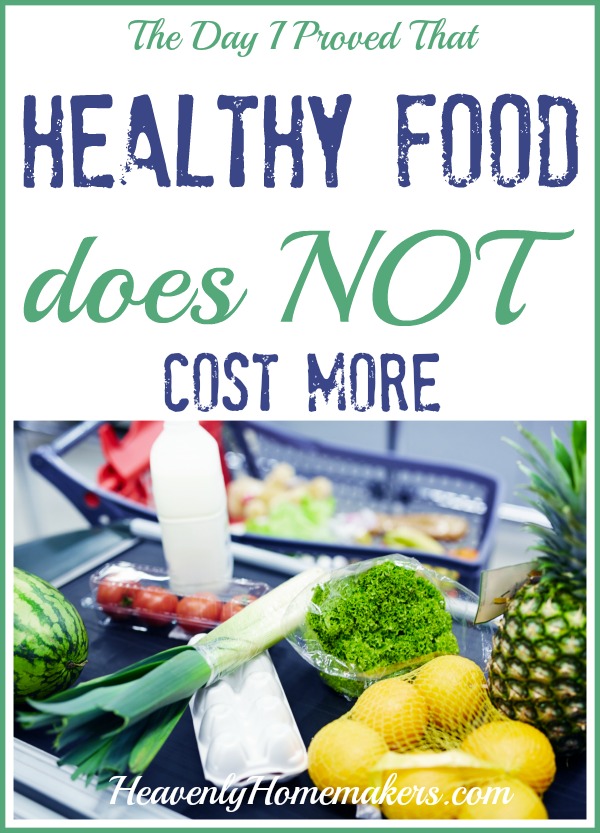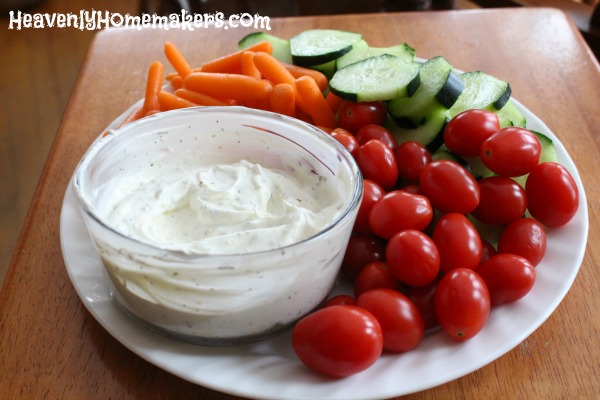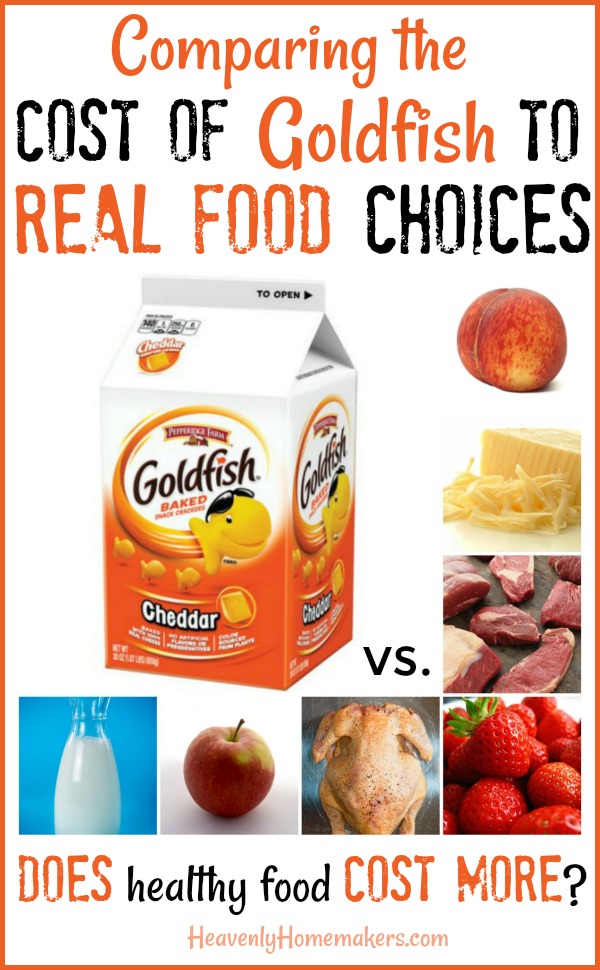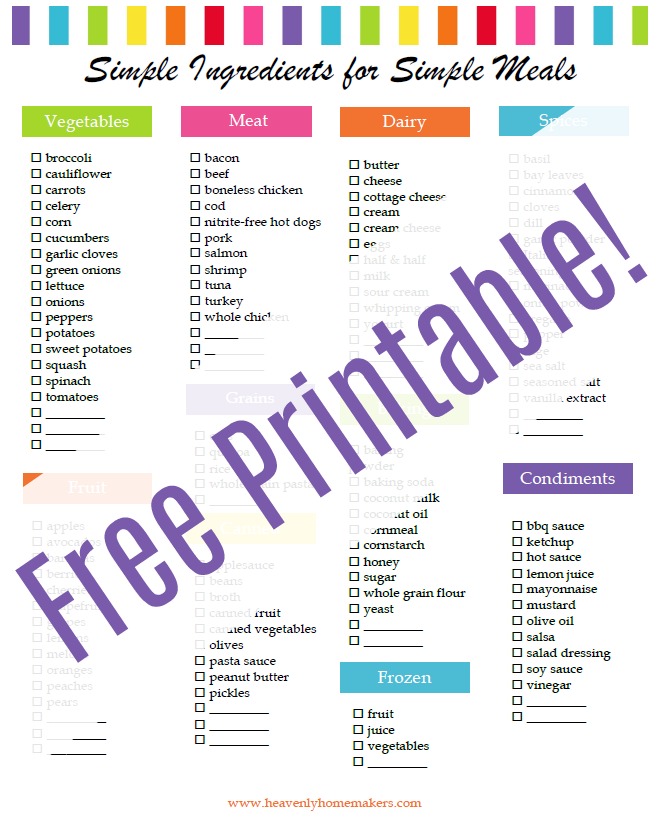Today I thought it would be fun to explore whether or not healthy food actually costs more than…how should I say it? Unhealthy food? Would you believe me if I told you that I discovered that most healthy food does not cost more? Some healthy foods actually cost significantly less! Who knew?

I don’t even like to call it healthy and unhealthy food, simply because not every person’s dietary needs are the same. Sometimes what’s healthy for me might not be healthy for you.
So as we talk through this subject, let’s switch the word “healthy” with the word “nourishing.” I always encourage people to focus on eating food that offers nourishment. Don’t just eat edible stuff that fills a hole. Work to eat real food that offers nutrients and provides the body with goodness to thrive.
Want to read more on this subject? Read this —>
What is the Perfect Diet for Everyone?

Now back to our initial discussion about the cost of nourishing food vs. the cost of empty calories.
I’ve been crunching some numbers this week because after all my years of working to make a nourishing diet affordable for my family, I still hear so many people talk about how they can’t afford to eat good food. I always cringe at this declaration because I no longer believe it to be true.
Does Healthy Food ACTUALLY Cost More?
In an effort to get to the bottom of this debate, today I decided to compare the prices of basic, real foods to the price of a big box of Goldfish Crackers from Walmart.
Obviously this comparison doesn’t factor in coupon use or off brand options. But spoiler alert: Would you believe me if I told you that an ounce of Goldfish Crackers costs only a little bit less than an ounce of Grass-Fed Organic Hamburger Meat?? This blew me away! Is it possible that we’ve been wrong all these years about the high cost of real food?

Check this out! You’ll be amazed at my findings!
Goldfish Crackers = 30 ounce box for $6.46 = $0.22/ounce
Keep this price point in mind as we look at the costs of other basic, real, nourishing foods most of us love. We’ll start by comparing average costs of favorite fresh fruits and veggies.
Cost of Fresh Fruits and Vegetables
Here’s the breakdown of produce price points I usually shoot for. NOTE: These are the prices I pay. Prices will vary from city to city.
- Grapes = $2.50/pound or less = $0.16/ounce
- Apples = $1.50/pound or less = $0.09/ounce
- Strawberries = $2.30/pound or less = $0.14/ounce
- Bananas = $0.59/pound or less = $0.04/ounce
- Carrots = $0.99/pound = $0.06/ounce
- Cuties = $1.50/pound or less = $0.09/ounce
- Peaches/Nectarines/Plums = $1.50/pound or less = $0.09/ounce
These are all much lower in cost compared to Goldfish Crackers. How fun is this?!
Cost of Fresh Meat, Milk, Eggs, and Cheese
This was a little bit more difficult to measure as we don’t calculate eggs or milk in pounds. Still, it was interesting to note some price breakdowns of these nourishing foods. Notice how many of these prices are significantly less per ounce compared to Goldfish Crackers! NOTE: These are the prices I pay. Prices will vary from city to city.
- Free Range Eggs = $2.50/dozen or less = $0.21/egg
- Cheese = $4.00/pound = $0.25/ounce
- Raw, Grass Fed Milk = $5.00/gallon = $0.04/ounce
- Grass Fed Beef = $5.50/pound = $0.34/ounce
- Naturally Grown Boneless Chicken Thighs = $3.00/pound or less when I see mark-downs = $0.19/ounce
- Naturally Grown Chicken Legs or Whole Chicken = $2.50/pound or less when I see mark-downs = $0.16/ounce
Wow! Bring on the nourishing, real foods!
Cost of Whole Grains
I typically purchase my grains in bulk through Azure Standard. (Curious how many cups of flour in a pound of wheat? I did the math for you here.)
- Freshly Ground Organic Wheat Flour = $1.00 per pound = $0.33/cup = $0.06/ounce
- Organic Brown Rice = $1.10/pound = $0.07/ounce
- Organic Rolled Oats = $0.87/pound = $0.05/ounce
- Organic Whole Wheat Pasta = $2.55/pound = $0.16/ounce
Healthy Food Does Not Cost More
With the exception of fresh cheese and grass fed meat, which is only a few cents more per ounce than Goldfish Crackers, we see a lower price on all real, whole foods compared to this empty calorie snack. I am so encouraged by this!
This isn’t to say that we should never eat a goldfish cracker. Some moments in our life call for fun convenience foods! But we should never feel discouraged or defeated about the cost of purchasing wonderful, nourishing food for our family!
I can do it! You can do it!
Are you surprised about these price comparisons? What are some of your favorite inexpensive real foods?
Free Simple Ingredients Printable List

We’ve created a wonderful, practical, basic real food ingredients list for you to download and use as a guide. Now that you know that real food is so affordable, this list will be even more helpful than ever! This resource is free and it’s for everyone. Get yours here!

And if you get grass fed beef at Aldi, it’s $3.99 a pound here in VA, most likely making it cheaper than those goldfish! I love this post! Thank you!!
Yes, I agree that more nourishing foods are really very affordable–until recently, I never really understood how people could think they could only afford highly processed foods (I mean, you can get a pound of carrots for $1, and a bag of chips costs $4), but… which is more filling?
An ounce of goldfish crackers has a higher volume than most, if not all of, the more nourishing choices you highlighted, which means one can eat fewer ounces of goldfish crackers to satisfy hunger, which means we need to buy more ounces of the nourishing foods than we do of the empty calorie foods in order to not feel hungry (I don’t have either in front of me, but I feel like 1 ounce of goldfish has about the same volume as 3-4 ounces of beef). I think that’s why people feel like they can’t afford nourishing foods.
I think another issue is that people are intimidated by making their own meals using real food, or feel like they don’t have time. So instead of buying yeast, flour or grain to grind, honey, oil, and salt, to make bread for about 23 cents per loaf, they buy a loaf of bread. The whole grain varieties cost $4 or more, while generic white bread costs around $1.
Add to that the issue of access–many folks don’t have access to nourishing foods. They would need to add bus or taxi fare on to the cost of their groceries. They generally have access to what can be kept on convenience store shelves, which is, unfortunately, highly processed and full-of-preservatives foods.
I don’t intend to discount your opinion, and I’m not trying to be mean–just pointing out another perspective. It’s more complicated than this post implies. And it’s also more simple than most people realize.
My favorite frugal nourishing food–dry beans! They’re filling, with high quality protein, fiber, and complex carbohydrates for steady release energy, not to mention so yummy, and I get mine for about 6 cents per ounce.
I love that you shared this perspective because it points out some of what I couldn’t address in just one post! Thank you!
Laura –
What an interesting post, and so true!!
Thanks for crunching all those numbers.
We eat healthy foods to, but by that I mean “real” food, not organic.
I don’t mean to be rude, but I wish you would have used a different comparison. We can eat a 1/4lb burger, or pig out on grapes, but we don’t typically eat the equivalent in goldfish crackers (which, if they are anything like cheese crackers don’t have any artificial flavors, colors or ingredients, though they aren’t exactly what I’d call “nutrient dense”!)
I agree healthy isn’t more expensive (I couldn’t even afford those goldfish crackers!). We usually stock up on produce, beans, a little meat, lots of beans, whole grain flours so I can make our bread (thank you for doing the kneading, bread machine!) and our family of four eats very well, with little “junk” for about $75/week :-)
I don’t see how raw milk teeming with bacteria is healthier than goldfish crackers, or how beef replete with saturated fat and cholesterol is healthier than goldfish crackers.
Please don’t derail this conversation with red herrings like drinking raw milk or eating beef. Laura prefaced the post by suggesting we look at this topic in terms of what nourishes each of us personally and compare that to the cost of foods that are clearly not nourishing.
I think this post is a great start to a conversation and our grocery budget is pretty low even though we mostly don’t eat processed foods and I mostly cook from scratch. However, when you factor in time spent I think you start to get a clearer picture of the cost. While it technically may only cost $0.23 to make a loaf of bread, as one commenter brought up, if you factor in time spent that loaf gets expensive. If I worked (I don’t right now) I’d be making around $20/hr (as an RN) so the 15-30 minutes it would take me to make two loaves of bread leaves my bread costing $2.50-5.00 worth of time per loaf. Obviously, not everyone could make the same amount of money, etc. It’s just an example. But it would be cool to have a comparison of similar foods for use and convenience. So I’d compare the goldfish to bananas, carrot sticks, cheese slices – stuff that has a similar prep time and use as goldfish (snack with basically no prep).
I agree your time is worth something, but while my hourly wage is high when I do work, I choose not to work many hours, so I can’t quite say I’d rather be making x at work than saving that at home. Plus I wouldn’t be making money 24/7. If I said I was choosing to not work a shift so I could save $2 at home, I would hope I was really enjoying that day at home. I love to cook so saving a few dollars cooking from scratch is also enjoyable, and not just for the money saving aspect.
“Doesn’t cost more” than what?
I definitely agree with your premise: healthy food is not un-affordable. And it is worth taking the time to make sure your family is eating the best they can! (I love your site and use several of your recipes regularly, like pita bread!)
But…the reference point of goldfish crackers isn’t necessarily where most people are starting from. We have recently begun to nearly double our produce intake: fruit for breakfast, two side veggies for dinner, and a big salad as part of lunch. The produce replaces things like store-brand pretzels (.08/oz), store-brand potato chips (.10/oz), pasta (.03/oz), and homemade muffins, rolls, and granola bars.
Our food budget has definitely increased. It’s worth it (we feel much better!), but it does cost more :)
Thank you for this great post! I just saw it shared on Facebook and replied with the following thoughts.
The “healthy food is expensive” myth is a HUGE pet peeve of mine. First of all, there isn’t a clear definition of “healthy.” I’ve seen people make false comparisons between out-of-season organic produce and $1 menu items. Secondly, we have to get over the “all or nothing” mentality. Just because it’s not organic and fresh doesn’t mean it’s not healthy – it may be “healthier” (although frozen produce has more nutrients than “fresh” produce that has been shipped hundreds or thousands of miles), but it’s a whole lot better than a diet of process foods. I have also done an ounce-for-ounce price comparison between junk food and the whole food it mimics (such as potato chips vs. potatoes, apple-flavored breakfast bars vs. apples) and the whole food wins every time – even beef jerky vs. farm-raised organic pork tenderloins comes out with the organic as cheaper by weight.
Thirdly, Americans pay a much smaller percentage of income for food than any other country – and it’s the cheapest it has ever been. Besides, with junk food, we’re paying for packaging and advertising. Healthy food, such as beans, whole grains, and frozen produce is extremely inexpensive – just look at what some of the dollar stores offer (and these are probably misleading and you might get a cheaper per ounce price at a grocery store). Compare how many meals you can make from that kind of meal with what you’d get from the dollar menu at a fast food restaurant. We also need to take into account the high price of health care linked to poor diets – eat healthy and you’re less likely to have medical bills.
In the US, we’ve traded convenience and leisure time for our health. When you look at the number of hours Americans sit on couches watching television and the state of our health (record obesity and chronic illnesses related to diet), it’s obvious that most of us have plenty of time to cook meals from scratch, take walks after dinner, etc. In fact, it’s essential to our lives that we start making changes.
We also need to factor in the learning curve. Sure, whole grains, fresh produce, and real dairy are probably more affordable than their processed counterparts. But if you buy more than your household uses, they spoil fast and that’s money wasted. It took me a while to be able to gauge just how much my family eats so that I am more adept at buying only what we can eat before spoilage. It also took me a while to accept that fact that I just do not enjoy eating or cooking certain things and, no matter how healthy they are, they go to waste because we just don’t gravitate to them so the best thing was to quit buying them and buy the healthiest storebought version I could find.